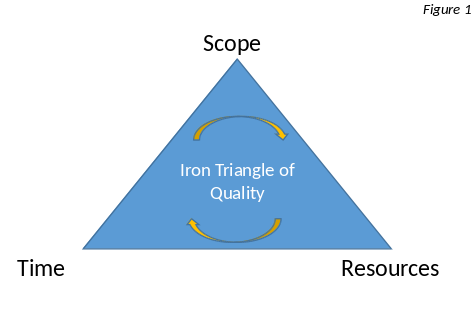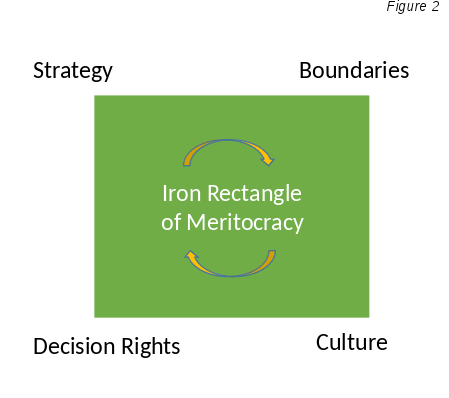Meritocracy is a common element of open organizations: They prosper by fostering a less-hierarchical culture where "the best ideas win." But what does meritocracy really mean for open organizations, and why does it matter? And how do open organizations make meritocracy work in practice? Some research and thinking I've done over the last six months have convinced me such questions are less simple—and perhaps more important—than may first meet the eye.
History and basic assumptions
Though the actual term was coined in the 1950s, the concept of meritocracy can be traced back to ancient history (even to classical Chinese and Greek culture), representing a system of governance whereby preference or power or rewards should accrue to "the best" (whether ideas, work, or other human creation). The essence of the concept is that merit for which power/reward is delivered should reflect some kind of competitive excellence. Meritocracy is the antithesis of privilege based on a candidate's birth, arbitrary position, or random luck.
Those of us who live in broadly democratic societies take for granted meritocracy in its most general sense: People with the best grades and test scores get into the most elite universities; the most evidence-rich and compelling arguments win the day in court; the baseball team with the best pitching and hitting wins the World Series. In business, sales people with the highest numbers get promoted; software that most delights customers wins awards and its developers command the highest salaries.
So what?
Meritocracy matters because competitive excellence is the basis by which we judge progress and make decisions in the western world; it's the engine of human performance and organizational growth.
Occasionally, when something other than merit influences a decision or outcome—a bribe is paid, personal favoritism skews a judge, or some accident of fate vaults a less qualified team into a championship—we shake our heads, saying "that's not how it's supposed to work."
The value of meritocracy is particularly essential for open organizations. In fact, it's really what makes "open" worthwhile (and "open" is in fact also a prerequisite for a well-functioning meritocracy). Competitive excellence in the open organization produces better results, in the same way that the U.S. Tennis Open produces better matches for all to see—by opening up and supporting competition among the best players in the world. He and she with the most awesome tennis skills and determination win the trophy.
When business leaders open up their programs and processes to finding the best—regardless of who might be suggesting an idea, or backing some initiative—higher performance results. Open software now consistently beats proprietary models because large universes of committed hackers keep finding and improving on bugs and broader design. In the meritocracy of open software communities, winning solutions result from competitive superiority of someone or some group's programming, not the resume or personal relationships among particular hackers: "code talks." Red Hat has adapted Linux-style meritocracy as part of its open organizational vision: an open culture, guided by meritocracy, Jim Whitehurst insists, has produced better innovation for the company (and thus overall performance).
Complications in practice
It all seems simple and logical enough: open up competition, let the best prevail and reap the benefits of getting great results. But putting meritocracy into practice is not as easy as it looks.
To judge by conversations I've had with practitioners in about a dozen "open-style" organizations (both for-profit and not-for-profit), "simple" meritocracy also seems to require some adaptation and evolution in the context of their cultures and strategy. My interviews didn't attempt to do a full practice analysis across all examples, but I got a glimpse of a range of implementation challenges, and more than a little variety of how different companies simply understand the concept.
"What," I asked, "does meritocracy mean in actual practice for you, in the context of work in your organization?"
Here's a sampling of what I heard:
- "Meritocracy is advancement of people based on a combination of their ability, achievement, and contribution."
- "It's when the best ideas win, but here it's not always clear who decides what's best."
- "It simply means the values and preferences of people in charge of the company."
- "When people achieve their OKRs ("objectives and key results") but only as those are judged by other people in the organization."
- "It's excellence based on the crowd-sourced feedback of others. But it depends who's in the crowd."
- "Striving to be the best, but different contexts will define it differently, depending on whether you evaluate the excellence within the organization or compare it to higher performance beyond it."
- "Embracing the best ideas, but unfortunately it's sometimes just who speaks the loudest and most often."
- "It's the tension between who is free to contribute to projects and who gets to make decisions about the projects."
- "It's the culture of an organization committed to the servant leadership model, i.e. having empathy for other people."
- "Awarding more responsibility to the people who work hardest and are most committed to some project. It's not so much results as the effort you give."
- "Organizations that strive to represent and reflect the diversity of backgrounds and abilities of our broader society."
- "Meritocracy is an old-fashioned concept that we actually discourage, preferring instead excellence based on collaboration and contribution to others."
My initial impressions, as I began this research, was that many of the people I was interviewing simply didn't understand what meritocracy was supposed to mean. But as I continued to hear a range of responses to my question, I became more humble. Meritocracy is easy to describe in theory, but how it gets put in practice is less easy. No wonder it can be perceived in so many different ways.
Touching many moving parts
Because everything in an organization must ultimately relate to its final performance, deciding the what, how, who, when of determining "excellence" or "merit" will touch many moving parts of a company, and impinge on many policies and practices, both high and low. Also, with today's changes in technology, globalization and patterns of competition, companies are experimenting with radical new forms of organization. As they do, we should expect that ideas about fostering and defining excellence will face their own turbulent disruptions.
Reviewing the interview comments cited above, I began to recognize a range of issues that meritocracy in practice ultimately forces forward, demanding creative "design decisions" by builders and other leaders of open organizations. For example:
- On what basis should merit be assessed in our company? Simple results? Results and effort? Results, effort, and talent (i.e. potential)? Why?
- Should meritocracy be redefined away from older definitions stressing only results, to have a meaning more reflective of social justice?
- How important is the process by which excellence is discovered and promoted? If the best ideas haven't emerged from a fair process, are they still the best? Or if behavior and mindsets contrary to who we want to be as an organization happen to produce something brilliant, should we nonetheless discount the idea?
- How wide should be the arena of competition in our quest for merit? Within a function? Across the company? Within the industry? Anywhere, anytime across the globe? Does meritocracy require different approaches to different arenas at different time? How and when?
- Should merit in best ideas be separated from merit in deciding how to apply them?
- Is meritocracy an independent variable or dependent variable of company culture? Does it emerge from a broader way of working by a particular company, or does it set the compass as a first principle to shape the rest of the organizational values and beliefs?
Such issues are frankly only a subset of a much larger list that could be generated. In the end meritocracy sits at the heart of multiple processes, structures, and values in any organization aspiring to flourish through human invention and collaboration rather than compulsion by an authoritarian regime. As such it may rightly be called a governance system—with all the complexity that implies.
Mapping Pandora's Box
In sum, a simple question—"What does meritocracy mean for you?"—posed to any open-style organization will likely generate a Pandora's Box of follow-on questions when it comes to putting the notion into practice. More study and more disciplined analysis of living examples are necessary for understanding the "how" and "when" of implementing meritocracy in open organizational models.
As a final thought, however, this preliminary investigation has suggested to me a simple framework that might help guide open organization leaders today: a blueprint of four higher level design questions that I see lurking across the stories and interviews I have collected. This framework might also help kick-start more detailed investigation of meritocracy in the future.
Iron interdependencies
Let me explain this framework by an analogy to another simple and well-regarded framework from another context, the so-called "Iron Triangle of Quality" (also called Iron Triangle of Project Management).
In the 1980s and 1990s, during the era of the "Quality Movement," specialists and project managers regularly invoked a timeless truth of some classic trade-offs at work. Developing any product or service for a certain level of quality always seems to depend on three variables: the scope of the project to build it, the time allowed to build it, and the resources available to do the job (i.e. its cost).
In fact, these three variables intimately depended on each other in achieving particular quality. If you increased the scope of a project (e.g., the number of features and functionality of the product), you would have to increase the project resources/cost or the time you could invest to build the product (or some combination of all). If you decreased the cost or the time to build it, to maintain a certain level of quality, you would have to reduce the scope. If you increased the cost, you might be able to build to a certain quality in less time. And so on and so forth.

Courtesy of Brook Manville (CC-BY-SA)
The interrelationship and inevitable trade-offs between such variables that drive quality became known as the "Iron Triangle"—you couldn't change one without either changing the others or changing the overall quality which the variables themselves produce (see Figure 1).
The iron rectangle
Let me suggest that with meritocracy, there are fundamentally not three but four, inter-related variables; taken together they set the parameters of shaping competitive excellence in any open organization. We might call these four the "Iron Rectangle of Meritocracy."
First is the Strategy: How does the enterprise create distinctive value for its customers? And on what kind of excellence (best ideas, best talents, best knowledge, etc.) does creating that excellence depend?
Second is Boundaries: How widely will the enterprise seek competition to find its excellence? Will it confine competition for merit to certain parts of the organization? The entire organization? Beyond boundaries, to include networks, value chains, volunteers, etc.?
Third is Decision Rights: Who will decide and make final judgments about what is "the best" (knowledge, ideas, talent, etc.)? Will it be an elite? Some sub-set of the broader organization? The entire organization or even some extended community? Will different entities decide at different times, or for different situations? Will certain entities have the power to override the judgment of other entities?
Fourth is Culture: What are the values and beliefs, the mindsets and ways of working across the enterprise that will adjust, contextualize or give proper meaning to what we deem "the best?" Will we only judge the best on the basis of "hard" measurable results, or will we include attributes that reflect our reverence for certain processes? For certain diversity of participation? For alignment with certain ethical values?

Courtesy of Brook Manville (CC-BY-SA)
Framing design decisions
Like the Iron Triangle of Quality, this Iron Rectangle of Meritocracy (see Figure 2) will shift and change when different assumptions are made about its core variables.
For example, for a particular organization, a strategy to prevail based on low- cost products will emphasize competition for certain cost-optimizing skills and knowledge which may require changes in culture, boundaries, and governance.By contrast, if a company seeks to pursue a strategy based on collaborative competition for innovation, it may require changing its decision rights to give more authority (say) to designers and engineers, which will in turn have implications for boundaries and culture. Emphasizing certain cultural values in the search for excellence—for example ensuring a commitment to diversity and civility in debate (as represented, for instance, in Red Hat's Open Decision Framework)—may well influence a company's boundaries, decision rights and even its strategy.
Like the Iron Triangle of Quality, this Iron Rectangle of Meritocracy does not lead one to the same operating approach or combination of design elements for all open organizations, nor does it stipulate what kind of open organization must always be built. It simply helps leaders—potentially at any level of the organization—to understand, when the competition for excellence gets underway, who's on the field, what it means to win, who will decide that, and how the game should be played—all of which any performance-driven open practitioner should be happy to understand.






4 Comments